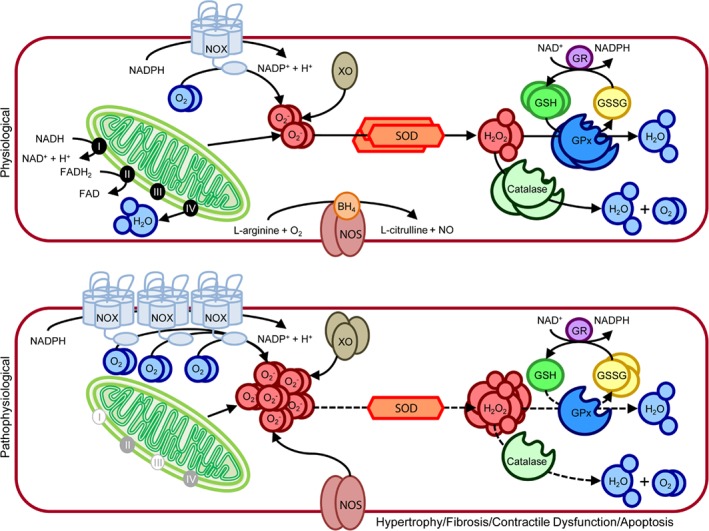Figure 2.

Oxidative stress production and scavenging in cardiomyocytes under physiological and pathophysiological conditions. (Top) Under physiological conditions oxidative stress in the form of reactive oxygen species (ROS) is produced in small quantities by the mitochondrial electron chain, NADPH oxidase (NOX), xanthine oxidase (XO), and nitric oxide synthase (NOS). Mitochondrial respiration converts oxygen to water, resulting in the production of small quantities of superoxide (O2 ‐) as a by‐product. The process starts with electrons derived from NADH2 and FADH2 moving along the respiratory transport chain through a series of cytochrome‐based complexes (I, III, and IV). These complexes eventually transport electrons to molecular oxygen. The high free energy of the electrons is gradually extracted and converted into adenosine triphosphate. NOX is a multimeric complex composed of a plasma membrane spanning cytochrome b558 (NOX2) and cytosolic components (Rac1, p47phox, p67phox, p40phox). Under physiological conditions this complex is in a resting state, producing minimal O2 ‐, by transferring an electron from NADPH to molecular oxygen. XO, which is a cytoplasmic enzyme that catalyzes the oxidation of hypoxanthine and xanthine to uric acid using molecular oxygen as an electron receptor, produces O2 ‐ and hydrogen peroxide (H2O2) in the process. NOS oxidizes the NOS cofactor BH4 utilizing NADPH to generate nitric oxide and L‐citrulline from L‐arginine and oxygen. Superoxide dismutase (SOD) initiates the detoxification of ROS, by scavenging O2 ‐ and converting it to H2O2. Both catalase and glutathione peroxidase (GPx) further detoxify the H2O2 to water and oxygen. GPx utilizes two glutathione (GSH) molecules as electron donors in the reduction of H2O2 to water, producing oxidized glutathione (GSSG) in the process. Once GPx oxidizes GSH to GSSG, GSH reductase (GR) can reduce GSSG back to GSH at the expense of NADPH, forming the GSH redox cycle. The ratio of GSH to GSSG largely determines the intracellular redox potential. (Bottom) Under pathophysiological conditions, oxidative stress production is increased as a result of increased NOX and XO expression, coupled to blockage of the mitochondrial electron chain and uncoupling of NOS. Furthermore, the expression and activity (dotted lines) of SOD, catalase, and GPx are reduced. The levels of GSH are also reduced, while the levels of GSSG are increased. This severe increase in oxidative stress eventually leads to hypertrophy, fibrosis, apoptosis, and contractile dysfunction in the myocardium.
